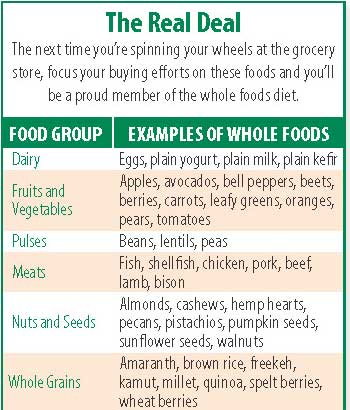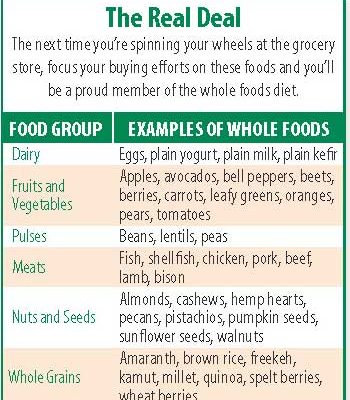In Search of Whole Foods
 From Mediterranean to Paleo to “Whole30” diet plans, there seems to be a common request among many of today’s popular eating styles. And that is to eat more whole foods. It’s a popular buzz word in social media and diet books. But what exactly are “whole foods” and why are we being told that they should form the foundation of our diets?
From Mediterranean to Paleo to “Whole30” diet plans, there seems to be a common request among many of today’s popular eating styles. And that is to eat more whole foods. It’s a popular buzz word in social media and diet books. But what exactly are “whole foods” and why are we being told that they should form the foundation of our diets?
What are Whole Foods? In layman’s terms, whole foods are foods that come closer to the way Mother Nature presented them. In other words, edibles that have not been highly processed and still resemble their natural forms. An easy example would be a whole potato versus French fries—it should be no surprise which of the two can be defined as a whole food. A fillet of wild salmon, pork tenderloin, or plain steak can be considered uncompromised whole foods. Battered fish sticks, bacon, and jerky? Not so much! To be even more rigorous, wheat berries would be deemed more of a whole food than would whole wheat bread. Ditto for brown rice compared to brown rice cakes or strawberries in relation to strawberry jam. A good way to know if you’re looking at a whole food is to consider the ingredients list. If it contains just one item, it’s much more likely to be au naturel.
The Degree of Processing Counts. But whole foods can also involve items that have been subjected to some degree of processing. For example, many nutritionists would deem plain yogurt that is made with little more than milk and cultures as a whole food, whereas heavily sweetened yogurt that is more akin to dessert would not fit the bill. Chicken breast takes some butchery to get on store shelves but is much more of a whole food than are chicken nuggets. Foodies would like to consider a wedge of lovingly aged Parmigiano-Reggiano much more of a whole food than a slice of heavily processed American cheese.
The more we learn about nutrition, the more it seems we should be stuffing our grocery carts with mostly whole foods. That’s because whole foods—beans, whole fruits, vegetables and whole grains—retain more of their original health-hiking nutrients, fiber, and phytochemicals than their processed counterparts. So if you load up your plate with nutrition-plush whole foods you’ll net more nutrients per calorie consumed and perhaps keep trim in the process. A University of Florida study determined that people who gleaned more of their daily calories from phytochemical-rich foods, like berries and dark leafy greens, had an easier time maintaining healthier body weights.
—Matthew Kadey, MS, RD
The post In Search of Whole Foods appeared first on University Health News.
Read Original Article: In Search of Whole Foods »
Powered by WPeMatico


